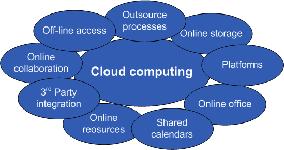 |
 |
Industrial Automation and the Cloud
By : Jim Pinto, The Internet of Things (IoT) will generate the next huge leap in industrial productivity. But IoT certainly won't bear fruit without ways to analyze all the data. Cloud computing is the enabler, the catalyst. Cloud/IoT has the potential to restructure automation industry leadership when the inflection point arrives.
November 2012
|

Over the past two decades, automation has improved the performance, quality and productivity of manufacturing and process systems. But performance remains at a plateau. Further improvements demand more data in real-time, which is beyond the capability of existing systems. In the last issue of Automation World (October 2012), I discussed how the Internet of Things (IoT) would generate the next huge leap in industrial productivity. But IoT certainly won't bear fruit without ways to analyze all the data. Cloud computing is the enabler, the catalyst for that inflection point. Use of "the cloud" is a transformative approach that provides more than just the conventional data center model. It fundamentally changes how masses of data can be stored for interaction. It offers services on demand at the infrastructure, platform and software levels. Big data, the cloud and analytics combine to offer breakthrough productivity solutions. Also in the October issue, David Greenfield wrote, "Databases are the refrigerators of the industrial world." They store information that is important, but only some of the data is used. Without a way to utilize accumulated data, it becomes outdated and useless. The problem is that it is not truly exploited. The cloud is the missing link. Cloud-computing technology is now at a maturing phase. Development of both private and public cloud systems has become a priority across a broad spectrum of commercial suppliers and users. Cloud services are becoming inexpensive and widely available, and enterprises can move or migrate workloads within and between their own data centers. Data center management still remains somewhat manual, but automated systems are becoming available to dynamically allocate resources for optimization in a wide range of applications. The cloud pushes away from fixed client-server architectures to a distributed architecture with local and global intelligence. In industrial applications, clear targets are manufacturing execution and production planning systems. There is minimal need for discrete servers that perform functions for only a few manufacturing processes when those can be operated more effectively as cloud services. Already in industrial automation, we're seeing applications of cloud computing to facilitate preventive and predictive maintenance, a major change-driver. This requires every possible machine parameter to be collected historically and analyzed to drive intelligent decision-making; this is not possible with only real-time analysis. Integrate the cloudAutomation suppliers can simplify the integration of cloud services into their products and systems in several ways: eliminate complex and/or proprietary architectures; use open communication standards; think in terms of services and not discrete products; and make sure that systems architecture properly scales into the cloud.Software architectures and tools created in previous decades will no longer fit the new cloud infrastructure. For example, with production plant monitoring, the ability to share development of application software with a distributed team from many locations was previously possible only in very few systems. Now distributed access and versioning should be built-in, and as easy to setup as accessing remote email. For cloud-based IoT systems, block-storage architectures that cannot provide instant snapshots of machine images will be prone to all sorts of failures. Those failures will grow more pronounced in the industrial automation world when a five-second failure could result in the loss of many millions of dollars worth of time-specific information. In addition to creating new markets and opportunities, cloud/IoT restructuring will overthrow many assumptions about who the industry's leaders will be and how they will establish and maintain leadership. The insightful Jeremy Pollard writes: "Definite-purpose devices have populated our software and hardware toolboxes for decades. The cloud might change it all." As the saying goes, you ain't seen nothin' yet. 
|
 Pinto's Points How to win in the Automation Business Go shopping - books, electronics, CD/DVD Selected advertising coming here. Contact Jim Pinto for rates. |
Return to Index of all JimPinto Writings

 Return to JimPinto.com HomePage
Return to JimPinto.com HomePage
If you have ideas or suggestions to improve this site, contact: webmaster@jimpinto.com
Copyright 2006 : Jim Pinto, San Diego, CA, USA
